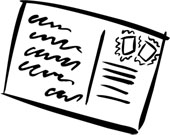 Stamp paper is obviously the most important part of a stamp—no paper, no
Stamp paper is obviously the most important part of a stamp—no paper, no stamp!! Also, the paper a stamp is printed on can mean the difference between a rare and valuable stamp, as opposed to one that is worth considerably less. When you start researching stamp paper (as I have recently!), you’ll easily be blown away by the sheer number of varieties that exist (as I was!). This article begins with outlining the first step—How is stamp paper made?
stamp!! Also, the paper a stamp is printed on can mean the difference between a rare and valuable stamp, as opposed to one that is worth considerably less. When you start researching stamp paper (as I have recently!), you’ll easily be blown away by the sheer number of varieties that exist (as I was!). This article begins with outlining the first step—How is stamp paper made?
 Lisa
Lisa
1868 1¢ Benjamin Franklin Z-Grill-USA’s rarest stamp!

One of the USA’s rarest single stamps is the 1868 1¢ Benjamin Franklin Z-Grill. Printed and grilled in 1868, the Z-Grill design was not used for very long, a couple of weeks at the most. That short production time is what accounts for it being so rare today. As explained in a previous article, a grill was a waffle-like design embossed on a stamp as a security measure to prevent reuse. See article: FAQ-What is a stamp grill?
FAQ-What is a stamp grill?

A series of late 19th century USA stamps are known for having “grills”. What is a stamp grill? Basically, a grill was a security method developed to prevent the fraudulent reuse of postage stamps.
Every time a stamp is used it is cancelled at the post office. A stamp can be cancelled by hand with a pen, or with a specially made canceling device. Unfortunately, many people would attempt (successfully!) to wash the cancellation ink off the stamp and then reuse it instead of buying a new one.
Top 5 FAQ for stamps

Here is a quick go-to reference article containing answers to the most common stamp questions. For more detailed answers, click on the link provided after each question.
1) What is my stamp(s) worth?
This has got to be the single most asked question in a stamp dealer’s lifetime! Basically, there are three things you can do.
Glossary of rare stamp terms

The rare stamps section of Arpin Philately is extremely popular. Collectors regularly keep an eye on it, on the lookout for little gems to add to their collection. Our rare stamp section also offers rarer stamps with slight faults or flaws in them which significantly lower their cost, enabling you to fill holes in your album for older stamps that otherwise you might not be able to afford.
FAQ-Should I repair or restore my stamp?

This is a very touchy and controversial subject. In short, if you have a rare, valuable, or classic stamp and you want to preserve its original value—the answer is «NO». The only time you should consider restoring such stamps is if they urgently require preservation, and then, only by a highly qualified professional.
Even if a stamp isn’t extremely valuable, many philatelists believe that altering a stamp in any way reduces its value and many don’t even want such stamps in their collection. For this reason, the American Philatelic Society stipulates that its members must identify a stamp that has been repaired or restored with an indelible ink mark—so that future buyers will know exactly what they are getting.
FAQ-How to preserve your stamps

You’ve invested in a stamp collection—now you want to keep it in pristine condition. Here are some tips to help you keep your stamps in tip-top shape.
Keep your stamps somewhere where you can control the temperature. Ideally, you should keep the room your stamps are in at 18°- 20 °C. Extreme heat or cold, or constant temperature fluctuations, can damage your stamps. If you store your stamps in bookshelves,
FAQ-What is the difference between a postmark and a cancellation?

The words “cancellation” and “postmark” are often used interchangeably, although strictly speaking this not completely accurate. This article will attempt to explain the actual difference between the two, while not establishing any hard and fast rules. After all, stamp collecting is supposed to be fun!
Kids Corner-Where do I get my stamps?

Lots of famous people have collected stamps. For example: Queen Elizabeth, President Roosevelt and John Lennon! Some of them started collecting stamps when they were very young and by the time they were adults they had a collection worth thousands, sometimes millions of dollars! But they had to start somewhere. Where did they get their stamps? Where can you get your stamps?
Kids Corner: Important stamp words

Now that you have started collecting stamps, here are some important stamp words that you can learn. Then you can impress everyone with how much you know!!
Adhesive: the glue on the back of a stamp (there are different kinds)
Block: a set of stamps still attached to each other in the shape of a square or a rectangle (usually in a square of 4 stamps)
Booklet: a little book of stamps, the cover is usually cardboard